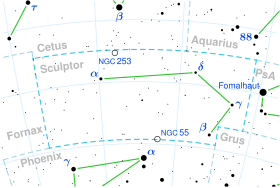Star in the constellation of Sculptor
Beta Sculptoris , Latinized from β Sculptoris, is a single, blue-white hued star in the southern constellation of Sculptor . It has an apparent visual magnitude of 4.37, which is bright enough to be seen with the naked eye. Based upon an annual parallax shift of 18.74 mas as seen from Earth, it is located 174 light years from the Sun .
A light curve for Beta Sculptoris, adapted from Pedersen et al. (2019) This is a B-type giant star with a stellar classification of B9.5IIIp(HgMnSi). It belongs to the class of chemically peculiar stars known as a Mercury-Manganese star , showing overabundances of mercury, manganese, and silicon in its spectrum . It is a suspected α CVn variable with magnitude variation from 4.35 to 4.39. The star has nearly three times the mass of the Sun and double the Sun's radius . It is radiating 81 times the Sun's luminosity from its photosphere at an effective temperature of 12,110 K.
References
^ Van Leeuwen, F. (2007). "Validation of the new Hipparcos reduction". Astronomy and Astrophysics . 474 (2): 653–664. arXiv :0708.1752 . Bibcode :2007A&A...474..653V . doi :10.1051/0004-6361:20078357 . S2CID 18759600 . Vizier catalog entry
^ Ducati, J. R. (2002). "VizieR Online Data Catalog: Catalogue of Stellar Photometry in Johnson's 11-color system". CDS/ADC Collection of Electronic Catalogues . 2237 . Bibcode :2002yCat.2237....0D .
^ Abt, Helmut A.; Morrell, Nidia I. (1995). "The Relation between Rotational Velocities and Spectral Peculiarities among A-Type Stars" . Astrophysical Journal Supplement . 99 : 135. Bibcode :1995ApJS...99..135A . doi :10.1086/192182 .
^ Watson, C. L. (2006). "The International Variable Star Index (VSX)". The Society for Astronomical Sciences 25th Annual Symposium on Telescope Science. Held May 23–25 . 25 : 47. Bibcode :2006SASS...25...47W .
Gontcharov, G. A. (2006). "Pulkovo Compilation of Radial Velocities for 35 495 Hipparcos stars in a common system". Astronomy Letters . 32 (11): 759–771. arXiv :1606.08053 . Bibcode :2006AstL...32..759G . doi :10.1134/S1063773706110065 . S2CID 119231169 .
^ Anderson, E.; Francis, Ch. (2012). "XHIP: An extended hipparcos compilation". Astronomy Letters . 38 (5): 331. arXiv :1108.4971 . Bibcode :2012AstL...38..331A . doi :10.1134/S1063773712050015 . S2CID 119257644 . Vizier catalog entry
^ Zorec, J.; Royer, F. (2012). "Rotational velocities of A-type stars". Astronomy & Astrophysics . 537 : A120. arXiv :1201.2052 . Bibcode :2012A&A...537A.120Z . doi :10.1051/0004-6361/201117691 . S2CID 55586789 . Vizier catalog entry
^ Allende Prieto, C.; Lambert, D. L. (1999). "Fundamental parameters of nearby stars from the comparison with evolutionary calculations: Masses, radii and effective temperatures". Astronomy and Astrophysics . 352 : 555–562. arXiv :astro-ph/9911002 . Bibcode :1999A&A...352..555A . Vizier catalog entry
Barraza, L. F.; Gomes, R. L.; Messias, Y. S.; Leão, I. C.; Almeida, L. A.; Janot-Pacheco, E.; Brito, A. C.; Brito, F. A. C.; Santana, J. V.; Gonçalves, N. S.; Das Chagas, M. L.; Teixeira, M. A.; De Medeiros, J. R.; Canto Martins, B. L. (2022). "Rotation Signature of TESS B-type Stars. A Comprehensive Analysis" . The Astrophysical Journal . 924 (2): 117. arXiv :2202.01022 . Bibcode :2022ApJ...924..117B . doi :10.3847/1538-4357/ac3335 . S2CID 246030494 .
"bet Scl" . SIMBAD Centre de données astronomiques de Strasbourg . Retrieved 2017-11-28.{{cite web }}: CS1 maint: postscript (link )
Chini, R.; et al. (2012), "A spectroscopic survey on the multiplicity of high-mass stars", Monthly Notices of the Royal Astronomical Society , 424 (3): 1925, arXiv :1205.5238 , Bibcode :2012MNRAS.424.1925C , doi :10.1111/j.1365-2966.2012.21317.x , S2CID 119120749 .
Pedersen, May G.; Chowdhury, Sowgata; Johnston, Cole; Bowman, Dominic M.; Aerts, Conny; Handler, Gerald; De Cat, Peter; Neiner, Coralie; David-Uraz, Alexandre; Buzasi, Derek; Tkachenko, Andrew; Simón-Díaz, Sergio; Moravveji, Ehsan; Sikora, James; Mirouh, Giovanni M.; Lovekin, Catherine C.; Cantiello, Matteo; Daszyńska-Daszkiewicz, Jadwiga; Pigulski, Andrzej; Vanderspek, Roland K.; Ricker, George R. (February 2019). "Diverse Variability of O and B Stars Revealed from 2-minute Cadence Light Curves in Sectors 1 and 2 of the TESS Mission: Selection of an Asteroseismic Sample" . The Astrophysical Journal Letters . 872 (1): L9. arXiv :1901.07576 . Bibcode :2019ApJ...872L...9P . doi :10.3847/2041-8213/ab01e1 . S2CID 118963697 .
Makaganiuk, V.; et al. (January 2011), "The search for magnetic fields in mercury-manganese stars", Astronomy and Astrophysics , 525 : A97, arXiv :1010.3931 , Bibcode :2011A&A...525A..97M , doi :10.1051/0004-6361/201015666 , S2CID 118860674 .
Categories :
Beta Sculptoris
Add topic
Text is available under the Creative Commons Attribution-ShareAlike License. Additional terms may apply.
**DISCLAIMER** We are not affiliated with Wikipedia, and Cloudflare.
The information presented on this site is for general informational purposes only and does not constitute medical advice.
You should always have a personal consultation with a healthcare professional before making changes to your diet, medication, or exercise routine.
AI helps with the correspondence in our chat.
We participate in an affiliate program. If you buy something through a link, we may earn a commission 💕
↑

